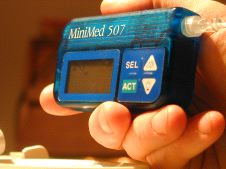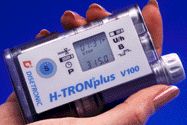This page as a pdf file
Rewriting the diabetes rulebook
John Neale discusses how his insulin pump changed his life
Introduction
Photo of John Neale, Bayreuth, July 2001
Twelve months ago I was cured of diabetes. Well, not exactly - but that's what it felt like. I was 32 and had had diabetes for 21 years. My health had always been good - but never really good. I had tried many different insulin regimes, searching for something that gave me the flexibility I needed for my work, combined with the good control I wanted. When I changed back to pork insulin I found things steadier and stopped having bad nighttime hypos. But still I couldn't get a good predictable blood glucose level (BG) through the night. Nor could I eat at a time and place that suited me.
Looking for better methods of control
These were meant to be the best years of my life, and they were rolling by in a whirl of irritability, fluctuating BGs and weariness. From the point of view of my diabetes clinic everything was just fine: I was articulate, motivated and never showed up in A&E. But I wanted better. I embarked on my own quest to establish what was the very best treatment regime available. I wanted to know what others in my situation did. The Internet was perfect for this. One excellent resource is the main diabetes newsgroup (misc.health.diabetes). One thing repeatedly surfaced: the people who were contented, happy and firmly in control of their diabetes and their lives were those using an insulin pump. I had heard a little about pumps before, and had assumed they were the treatment of last resort for people with uncontrollable diabetes. Nothing was further from the truth. In America and Germany, two countries I know well, pumps were now considered by many doctors to be the treatment of first choice if you lead a flexible life, want good control and are prepared to test your BG a lot. That's me.
Plan strategy to get pump
Photo of my MiniMed 507 insulin pump
My NHS diabetes clinic were unreceptive to my concerns about my less-than-perfect control, and knew nothing about pumps. So I saw a private diabetes specialist in London. He too knew little about pumps, but was sympathetic to my needs and concerns. After several visits he authorised my using a pump, but I was essentially on my own. The NHS continued to pay for my insulin and test strips, but I had to purchase the pump and fund its ongoing costs from my own pocket. And I negotiated a one month free trial before I was committed to buying it.
Amazing results
From day one my life was changed. There was no going back. I awoke on the first morning from the deepest soundest sleep I had ever experienced. And I woke refreshed! Previously I had usually woken tired and exhausted. Now I was bounding with energy. I no longer had waves of sleep rolling over me after lunch. And my character changed. This was immediately picked up by my colleagues at work. I became cheerful and contented and exuded enthusiasm. Small health problems cleared up. The persistent small amount of acne I always had disappeared. Athletes foot - gone. A healthy complexion came to my face for the first time. My face changed shape too: it became slimmer and lost that plumpness. That frequent feeling of needing to go to the toilet went. I now ate because I was hungry, and not because I was chasing insulin already in my system. I steadily shed weight, and was eating just whatever I wanted. I've also had no sore throats, flu or other illness since I started pumping. Previously I was always going down with something.
Description of pump
Disetronic HTron+ V100 insulin pump
Enough about me. The pump: it's about the dimensions of a credit card, and just over half an inch thick. It's light, rugged, and sits in my pocket without my knowing it's there. It holds about a week's worth of insulin, which travels by a 24" tube to wherever I have inserted the small Teflon cannula under the skin. This is inserted by injecting a needle with a thin plastic coating into the fat around my stomach; the needle is then removed, leaving the plastic tubing behind in the fat. I change the infusion set every 3 or 4 days. I can also swiftly disconnect it from my body, leaving the infusion set in, to take a bath, swim or have sex. At night the pump just lies safely alongside me in bed.
Humalog allows new rulebook
I use just Humalog - the very fast acting insulin. No other insulin enters my body. This allows me to throw the old diabetes rule book out of the window and write a completely new one. Let me describe the new rules. Two essential figures, and two new words:
- The insulin sensitivity factor is by how much 1 unit of insulin lowers my BG. In my case it's about 2.5 mmol/L (45 mg/dL)
- The carb/insulin ratio is how much carbohydrate is required for each extra unit of insulin taken with a meal. In my case about 15 grams of carbohydrate requires 1 unit of insulin.
- A bolus is the extra insulin you take when you eat carbohydrate. This corresponds to the old pre-meal injection.
- The basal is the insulin which maintains your BG when you haven't eaten recently. (Remember, even if you've not eaten recently you still need insulin. Insulin doesn't just push glucose out of the blood: it prevents it flooding back in again.) The basal rate is like the old slow acting (cloudy) insulin, but it's given gradually and measured in units per hour.
Correct basal rates very important
Getting the basal rate right is central to good control. Mine's about 0.9 units per hour during the day. I need a lower rate during the night, and a large increase between 6am and 10am. This is all pre-programmed into the pump's memory. The morning increase accommodates a phenomenon called the dawn effect where the body releases various hormones as part of its waking-up process. Unless I take more insulin at this time I wake up with a high BG, even though my night-time rate is correct.
Eat whatever you like...
Once my basal rates are correctly set, I can live my life just as I like. If I'm not hungry, I don't eat. Easy as that. My BG stays fine. If I'm hungry I eat, and I eat as much as I want. I estimate how much carbohydrate I'm eating and bolus the appropriate amount of insulin (using my carb/insulin ratio). Since Humalog works fast there's no need to take the insulin in advance. And since it's gone from the system quickly, there's no need to snack later to catch that late peak you get with Pork or Human Actrapid. In fact I often put my hand in my pocket and take more insulin during a meal if I decide to have a second helping of apple pie and custard...
Delaying the Humalog
If it's a slow digesting high fibre or high fat meal, I may take a few units with the meal, and a few units later after the meal. Or I may use the slow-bolus feature, which gives you the bolus gradually over the next few hours. This way you can avoid the fast action of the Humalog when you don't want it.
Correcting BG as you go
Since Humalog works so quickly, I can also use it to correct my BG if it's a little high. If it's say 11mmol/L, and I haven't eaten recently, I can take 2 units of insulin which (using my insulin sensitivity factor) will bring it down by 5mmol/L to about 6mmol/L within an hour or two. This allows me actively manage my BG. On the old injection system, if your BG was wrong, you had to adjust your insulin the following day, do everything else the same and hope the BG came out better. We all know that two days are never the same, and sometimes the BG just does what it wants irrespective of your best laid plans. Now I can respond to the situation as it happens.
Is this tight control really necessary?
Some doctors claim that this extra-tight control, with an actively managed BG, is unnecessary, as it does not reduce the risk of complications any further. This is irrelevant to me: what I know is that when my BG is high, I feel lethargic and irritable, and when it is normal I feel energised and enthusiastic. This is motivation enough for getting perfect BGs.
Old pump memories
Many doctors also remember only the "bad old days" of insulin pumps when they were first trialled in Britain in the 1980's. Many of the problems that prevented them being used have been overcome. They are now smaller, lighter, and very reliable. The stainless steel needles that scarred the skin and caused infections have been replaced by much better Teflon cannulas. And the special tubing no longer causes the insulin to crystallise and block the system.
Not perfect, but the best available
Pumping does not give perfect control. Diabetes is not like that. But it gives you the best possible control, and it puts directly in your hands the ability and responsibilty to handle situations yourself. I no longer have bad hypos. Ever. I eat whatever I want, whenever I want, if I want. My last HbA1c was 5.7%. Well, for now at least, that's almost as good as a cure.
Created: November 1999; Last updated: Tuesday 5 June 2001
Other pages about pumps
[ Funding issues | Pros and cons of pumping | Diabetes UK on pump therapy | Pumps in the Republic of Ireland | What is an insulin pump? | Just like wearing a yoyo | Not controlled, but in control! | Rewriting the diabetes rulebook | To pump or not to pump? | Pumps in pregnancy | Using the insulin pump during pregnancy | Life on a pump | UK pump news | Which pump? | MiniMed | Disetronic | Animas | Books to help with diabetes | Other pump websites | My pump ]
Other pages about food
[ What is a square-wave bolus? | Rewriting the diabetes rulebook | Calculating carbohydrates for recipes | Wearing a continuous glucose sensor | Books to help with diabetes ]
Reader comments
-
On 1 Aug 2005 Duane Keith wrote:
John, are you still there?? I ask as the last comment was three years ago...
I have been highly he-has-an-appliance-attached-I-feel-like-such-an-invalid-with-this-stupid-thing resistant to the idea of using a pump. Your article is, to the contrary, quite persuasive. Is it all still working for you? My brother wears one, but his sales talks are monosyllabic responses. My 22-year-old daughter wears one, and half of what she says to the old man on any topic is resentfully scornful, so no help from them.
-
On 2 Aug 2005 John Neale replied:
I am still here, thanks Duane :-) I had a health crisis September 2002 with a brain tumour, which was operated on successfully, and two lots of chemotherapy have kept regrowths at bay so far. Beyond that, pumping continues satisfactorily.
-
-
On 7 Aug 2002 Sam Watkins wrote:
I feel exactly the same way! It is not a cure, but it really is the next best thing. I was diagnosed in 1977, at the age of four and I had been through single shots per day to MDI. Having had my pump for nearly 10 months, I wouldn't go back to not having it! (As for not getting colds etc., I seem to have had a nasty bug since March! Without my pump, I just wouldn't have been able to cope with it!)
-
On 27 Feb 2001 Jeff Nobles wrote:
John, I'm in Houston, Texas, and have had type 1 diabetes since 1973. Thanks for your efforts in putting together this website. When I first found it several months ago, it gave me the initial push to begin seriously considering pump therapy. Hope to be wearing my own pump within the next month. Best wishes for your continued good health. --Jeff Nobles



